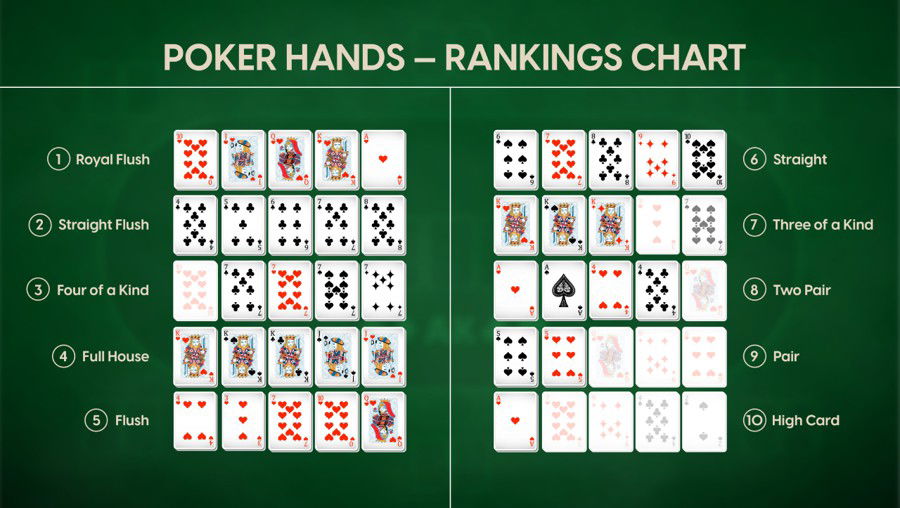Texas Holdem is the first thing to pop up in everyone's mind when someone thinks of poker. While there's quite a list of versions of this card game, Holdem poker is the most played variant globally.
That's why we've prepared a detailed guide on how to play the Texas Holdem game. You'll learn about the basic rules, hand ranks, important terms, and so on. This guide also contains practical poker tips and strategies.
Texas Hold'em: History, Facts, and Quick Gameplay Explanation
Players started playing it in Texas during the early 1900s. The game gained massive popularity in Las Vegas in the 1960s when it was included into World Series of Poker as the center of the tournament.
Here's a step-by-step explanation of the rules of one of the most popular poker games:
- Two player cards (hole cards). The dealer gives two private cards to each player. These cards are hidden from opponents.
- Pre-flop betting round. Players place wagers based on their hole cards. They can fold, call, or raise.
- Flop (three face cards). The dealer places three community cards face-up in the middle. Everyone can see and use them to combine with two hole cards.
- The betting round. Players bet again based on the new possibilities created by the flop.
- Turn (fourth card). The dealer adds one more community card face-up next to the flop.
- Betting round. Another round of betting happens after the turn appears.
- River (fifth card). The dealer places the final community card on the table.
- Final betting round and showdown. It's when players reveal their hands, and the one with the best combination wins the pool.
For example, four players join a table. The dealer gives each of them two hole cards. Player 1 has Ace of hearts and King of diamonds. Player 2 has Ten of clubs and Ten of hearts. Player 3 folds and Player 4 calls. The flop reveals King of hearts, Ten of spades, and Five of diamonds.
So, here's how it goes next:
- Player 1 now has the top pair.
- Player 2 has a set of tens.
- The turn shows a Two of clubs.
Now, Player 1 raises, and Player 2 calls. The river reveals a King of spades. Player 1 now has trip Kings, while Player 2 still has a full house. Player 2 wins after the showdown because the full house beats trip Kings. It may not make sense now, but it will later once we'll explain the ranks of poker hands.
A Detailed Guide on How to Play Texas Hold'em
Texas Hold'em has a simple structure with poker rules that determines when to bet, who make their moves first, etc. Here's a list that explains the main actions and roles:
- Small blind and big blind. The small blind places a partial bet. The big blind posts a full wager before cards come.
- Call. You match the current highest wager and stay in the round.
- Raise. You increase the bet and pressure others to match it or to fold.
- Fold. You give up your hand, so you stop playing the round.
- Position. Late position offers an edge because you act after others.
These were the main actions. They're applicable in poker online (RNG-base) and live poker.
Main Differences Between RNG-Based and Real Dealer Versions
Traditional, RNG-based and live dealer poker options work in different ways. The first one is based on you being at a land-based casino, the second uses algorithms to generate random results (through Random Number Generator), the third shows a real dealer via streaming.
All formats match different types of players. Some want a fast and quiet game. Others want a real table with human reactions. The online platforms on hrajspravne.com provide the last two options.
We've prepared a table that compares online poker vs. live vs. traditional:
| Characteristic | Traditional poker | Online poker (RNG-based or video poker) | Live dealer poker |
|---|---|---|---|
| Pace of the game | Slow and controlled by dealer and players | Fast and automatic | Moderate and controlled by dealer |
| Player interaction (level) | High and personal | Low or none | Medium and via chat |
| Bluffing/psychological play | Yes | No | No (unless the online casino allows users to connect via video chat) |
| Atmosphere and realism | Authentic and classic | Depends on the developer of online poker | Realistic and visual |
| Accessibility and convenience | Low and location-based | High and convenient | High and accessible via stable internet |
You play faster in online RNG-based rooms, but you lose human interaction. Traditional poker is more about trying to convince your opponents that you have a strong hand even if you don't. Live dealer Hold'em at an online casino is a mix of both, although interactions are still limited, specifically, the bluffing part.
Hand Ranks in Texas Hold'em
You need to understand Texas Holdem hands and how to form them before you even begin. We recommend trying the demo version to train and learn to form combinations, as it's a free version and is accessible online.
So, as promised, these are poker hands ranking from the best to weakest combination + explanations with examples:
- Royal flush. It's an unbeatable hand. It includes five suited cards from ten to ace, like these: A♠ K♠ Q♠ J♠ 10♠. You can expect to hit it in only 0.000154% of deals, which means once in every 649,740 hands.
- Straight flush. It's a combo of five consecutive cards of the same suite, for example, 9♦ 8♦ 7♦ 6♦ 5♦. The chance to get it is 0.00139%, or once in 72,192 hands.
- Four of a kind. It's a hand of four cards of the same rank + one side card. For example, J♦ J♠ J♥ J♣ 3♣. The odds are 0.024%, so about once every 4,164 rounds.
- Full house. You need a trio and a pair, like 10♥ 10♣ 10♠ 8♦ 8♠. This combo appears in 0.144% of games, which means once in 693 deals.
- Flush. You need five suited cards that aren't a sequence, like K♠ J♠ 9♠ 6♠ 3♠. The odds of getting it are 0.197%, or one in 508 combos.
- Straight. It's a combination of five consecutive cards in different suits, so anything like 7♣ 6♦ 5♠ 4♣ 3♥. You can expect it once in every 254 hands, with a 0.392% chance.
- Three of a kind. It has three cards of the same rank, like 5♦ 5♠ 5♣ K♦ 8♥, so you have 5s, and all others are irrelevant. It shows up 2.11% of the time, or once in 46 hands.
- Two pair. It includes two pairs and one additional card (any), like 9♠ 9♥ 6♣ 6♠ Q♦. It appears in 4.75% of hands, or one in every 20.
- One pair. You have one pair and three unrelated cards, like A♦ A♣ 7♠ 4♥ 2♦ counts. You'll see it in 42.26% of combinations, or once every 1.3 rounds.
- High card. The highest card decides the strength when you have no combinations. For instance, Q♦ 10♠ 7♥ 5♣ 2♠ is a typical example. This hand hits 50.12% of the time, or once every 1 hand.
The combination you get in Texas Holdem online or live should help you decide on your actions. Top hands mean you can raise or call, weaker combos mean you should think twice about what you do.

Strategies and Recommendations to Play Hold'em Successfully
You'll have to adjust your style, depending on whether you play Texas Holdem poker online (so no bluffing at all) or in person (at a land-based casino). So, here's a list of some Texas Holdem strategy suggestions and tips:
- Trap aggressive opponents, but only if you have a strong hand; raise once they bet. This move increases the pot and exposes their overconfidence + you can win the entire pool (unless they weren't bluffing).
- Bluff that you have a strong hand. It's best to play a few successful rounds, so opponents will fall for the trick.
- Try semi-bluff, which is when your hand isn't great, but has the potential to be better after new card deals.
- Call or raise once you have better hands when you sit in the blinds. Use this tactic if you notice opponents trying to steal pots with weaker cards.
- Raise with medium or weak hands when others show weakness after the flop. Use this strategy only if you sit in a late position and no one seems to be successful.
You should also understand when to be and not to be aggressive. For example, apply when you control the table or have a strong combo. But be careful when playing from an early position (before everyone else wagers) or with hands that can turn bad.
Red Flags in Texas Hold'em: What Not to Do
It's good to know how to act, but you should also understand the "don'ts" of Hold'em. Here's a list of Texas Holdem tips that explain what behavior to avoid:
- Never enter the game with bad cards just to see the flop; you'll just lose chips faster.
- Don't act without considering your position (early or late) at the table.
- Don't bluff too often, especially if you don't have the grounds to do so (like when you didn't convince others that you're a pro by winning a few times).
- Play only with AQ combos or similar just because they look premium; you lose other potential opportunities.
Stay cool and try to understand the behavior of your opponents, not how they yawn or twitch: that seems to work only in movies. You should wager considering your position, bluff if you manage to convince everyone that you can collect stronger hands, and react to similar behavior of others.











— Comments 0
, Reactions 1
Be the first to comment